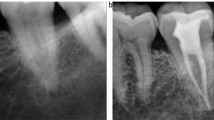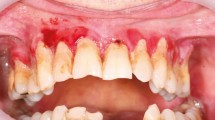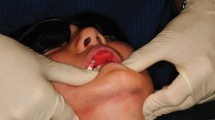Abstract
The assessment of restorability is necessary to determine whether it is possible to predictably restore a tooth once primary disease has been managed.
There are a multitude of factors that may determine the restorability of a tooth. It varies on a case-by-case basis and as such, clinicians must consider both local tooth factors and general patient-related factors, ensuring a holistic approach when assessing these patients.
This article discusses the many factors that determine a tooth's restorability, including a review of the current indices available to clinicians to aid in this process.
Key points
-
An assessment of restorability should be performed before restorative dentistry secondary care referrals.
-
Outlines the key factors to consider when assessing the extent of disease and restorability.
-
Improving restorative dentistry secondary care referrals will improve patient outcome and healthcare economics.
This is a preview of subscription content, access via your institution
Access options
Subscribe to this journal
Receive 24 print issues and online access
$259.00 per year
only $10.79 per issue
Buy this article
- Purchase on Springer Link
- Instant access to full article PDF
Prices may be subject to local taxes which are calculated during checkout










Similar content being viewed by others
References
Burke F J T, Lucarotti P S K. The ultimate guide to restoration longevity in England and Wales. Part 5: crowns: time to next intervention and to extraction of the restored tooth. Br Dent J 2018; 225: 33-48.
Pjetursson B E, Brägger U, Lang N P, Zwahlen M. Comparison of survival and complication rates of tooth-supported fixed dental prostheses (FDPs) and implant-supported FDPs and single crowns (SCs). Clin Oral Implants Res 2007; DOI: 10.1111/j.1600-0501.2007.01439.x.
Opdam N J M, Bronkhorst E M, Loomans B A C, Huysmans M C D N J M. 12-year survival of composite vs. amalgam restorations. J Dent Res 2010; 89: 1063-1067.
Foster L V. Failed conventional bridge work from general dental practice: clinical aspects and treatment needs of 142 cases. Br Dent J 1990; 168: 199-201.
Da Rosa Rodolpho P A, Cenci M S, Donassollo T A, Loguércio A D, Demarco F F. A clinical evaluation of posterior composite restorations: 17-year findings. J Dent 2006; 34: 427-435.
Lucarotti P S K, Holder R L, Burke F J T. Outcome of direct restorations placed within the general dental services in England and Wales (Part 1): variation by type of restoration and re-intervention. J Dent 2005; 33: 805-815.
Mjör I A, Moorhead J E, Dahl J E. Reasons for replacement of restorations in permanent teeth in general dental practice. Int Dent J 2000; 50: 361-366.
Javidi H, Tickle M, Aggarwal V R. Repair vs replacement of failed restorations in general dental practice: factors influencing treatment choices and outcomes. Br Dent J 2015; DOI: 10.1038/sj.bdj.2014.1165.
Abbott P V. Assessing restored teeth with pulp and periapical diseases for the presence of cracks, caries and marginal breakdown. Aust Dent J 2004; 49: 33-39.
Jotkowitz A, Samet N. Rethinking ferrule-a new approach to an old dilemma. Br Dent J 2010; 209: 25-33.
Samran A, El Bahra S, Kern M. The influence of substance loss and ferrule height on the fracture resistance of endodontically treated premolars. An in vitro study. Dent Mater 2013; 29: 1280-1286.
Stankiewicz N R, Wilson P R. The ferrule effect: a literature review. Int Endod J 2002; 35: 575-581.
Juloski J, Radovic I, Goracci C, Vulicevic Z R, Ferrari M. Ferrule effect: a literature review. J Endod 2012; 38: 11-19.
Mamoun J S. On the ferrule effect and the biomechanical stability of teeth restored with cores, posts, and crowns. Eur J Dent 2014; 8: 281-286.
Stankiewicz N, Wilson P. The ferrule effect. Dent Update 2008; 35: 222-228.
Fontana P E, Bohrer T C, Wandscher V F, Valandro L F, Limberger I F, Kaizer O B. Effect of Ferrule Thickness on Fracture Resistance of Teeth Restored With a Glass Fiber Post or Cast Post. Oper Dent 2019; DOI: 10.2341/18-241-L.
Nascimento A S, Rodrigues de Oliveira L J, Moura A T et al. Does ferrule thickness influence resistance to fracture of endodontically treated teeth? J Conserv Dent 2018; 21: 613-617.
Ng C C H, Dumbrigue H B, Al-Bayat M I, Griggs J A, Wakefield C W. Influence of remaining coronal tooth structure location on the fracture resistance of restored endodontically treated anterior teeth. J Prosthet Dent 2006; 95: 290-296.
Ng Y-L, Mann V, Gulabivala K. Tooth survival following non-surgical root canal treatment: a systematic review of the literature. Int Endod J 2010; 43: 171-189.
Ng Y-L, Mann V, Gulabivala K. A prospective study of the factors affecting outcomes of non-surgical root canal treatment: part 2: tooth survival. Int Endod J 2011; 44: 610-625.
Orstavik D. Time-course and risk analyses of the development and healing of chronic apical periodontitis in man. Int Endod J 1996; 29: 150-155.
Setzer F C, Shah S B, Kohli M R, Karabucak B, Kim S. Outcome of endodontic surgery: a meta-analysis of the literature - part 1: Comparison of traditional root-end surgery and endodontic microsurgery. J Endod 2010; 36: 1757-1765.
Jadun S, Monaghan L, Darcey J. Endodontic microsurgery. Part two: armamentarium and technique. Br Dent J 2019; 227: 101-111.
Chen S-C, Chueh L-H, Hsiao C K, Wu H-P, Chiang C-P. First untoward events and reasons for tooth extraction after nonsurgical endodontic treatment in Taiwan. J Endod 2008; 34: 671-674.
West N, Chapple I, Claydon N et al. BSP implementation of European S3 - level evidence-based treatment guidelines for stage I-III periodontitis in UK clinical practice. J Dent 2021; DOI: 10.1016/j.jdent.2020.103562.
Beddis H P, Okechukwu N, Nattress B R. 'The last post?': assessment of the failing post-retained crown. Dent Update 2014; 41: 386-394.
Moghaddam A S, Radafshar G, Taramsari M, Darabi F. Long-term survival rate of teeth receiving multidisciplinary endodontic, periodontal and prosthodontic treatments. J Oral Rehabil 2014; 41: 236-242.
Van de Sande F H, Opdam N J, Rodolpho P A D R, Correa M B, Demarco F F, Cenci M S. Patient risk factors' influence on survival of posterior composites. J Dent Res 2013; DOI: 10.1177/0022034513484337.
Theobaldo J D, Catelan A, Rodrigues-Filho U, Marchi G M, Lima D, Aguiar F. Effect of Cigarette Smoke on Resin Composite Bond Strength to Enamel and Dentin Using Different Adhesive Systems. Oper Dent 2016; DOI: 10.2341/15-056-L.
Burke F J, Wilson N H, Cheung S W, Mjör I A. Influence of patient factors on age of restorations at failure and reasons for their placement and replacement. J Dent 2001; 29: 317-324.
Dawood A, Patel S. The Dental Practicality Index - assessing the restorability of teeth. Br Dent J 2017; 222: 755-758.
Bandlish R B, McDonald A V, Setchell D J. Assessment of the amount of remaining coronal dentine in root-treated teeth. J Dent 2006; 34: 699-708.
Tamse A, Fuss Z, Lustig J, Kaplavi J. An evaluation of endodontically treated vertically fractured teeth. J Endod 1999; 25: 506-508.
Tsesis I, Rosen E, Tamse A, Taschieri S, Kfir A. Diagnosis of vertical root fractures in endodontically treated teeth based on clinical and radiographic indices: a systematic review. J Endod 2010; 36: 1455-1458.
Esteves H, Correia A, Araújo F. Classification of extensively damaged teeth to evaluate prognosis. J Can Dent Assoc 2011.
Kumar N, Brooke A, Burke M, John R, O'Donnell A, Soldani F. The oral management of oncology patients requiring radiotherapy, chemotherapy and/or bone marrow transplantation. Faculty Dent J 2013; 4: 200-203.
Author information
Authors and Affiliations
Contributions
Jacob Watts, Don S. Jayawardena, Reem Ahmed, Joanne Cunliffe and James Darcey all contributed to the literature search and the writing and drafting of the manuscript, as well as subsequent revisions.
Corresponding author
Ethics declarations
The authors declare no conflicts of interest.
Rights and permissions
About this article
Cite this article
Watts, J., Jayawardena, D., Ahmed, R. et al. Considerations for restorative dentistry secondary care referrals - part 2: predictability of treatment. Br Dent J 233, 101–108 (2022). https://doi.org/10.1038/s41415-022-4446-9
Received:
Accepted:
Published:
Issue Date:
DOI: https://doi.org/10.1038/s41415-022-4446-9



